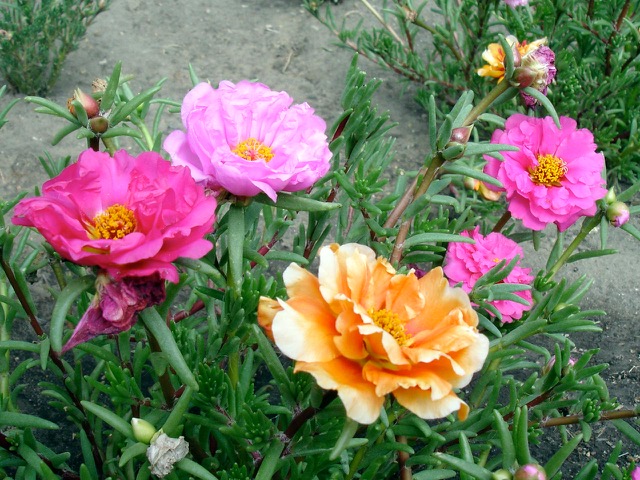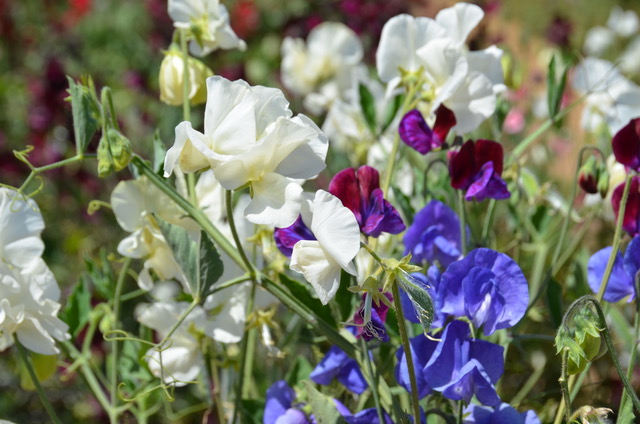By Cynthia B. Lauer, Master Gardener, SCMG
There’s no better way of inviting lavish colour into your garden than annuals. Whether at the edges of perennial beds, in containers, or tucking them between shrubs, attractive annuals of all shapes and sizes are just the thing. Every spring, gardeners flock to nurseries to buy shade-tolerant begonias, coleus, fuschia, geraniums, and pansies or sun-lovers like nasturtium, petunias, dahlias, dusty miller, and lantana. What a surprise it is to learn that, botanically speaking, none of these plants are true annuals. Many plants sold as annuals are perennials in their native habitats. They are marketed as annual ornamentals since “tender” perennials do not survive in cool outdoor weather.
An annual is any plant that completes its life cycle in one growing season before naturally dying. But those that self-seed perform like a perennial and come up every year. The difference is that herbaceous perennials naturally reproduce from seed but they return every year from regrowth at its vegetative root, tuber, corm, bulb, or rhizome. True annuals begin from seed and only seed.
BENEFITS
Unlike tender perennials marketed as annuals, self-seeding annuals do not present the gardener with two difficult choices—bring them indoors in the fall where they will hopefully remain pest-free and go dormant, or let them die off over winter. Since they don’t have to be replaced every year, self-seeding annuals are easy on the budget. A key element in the low-maintenance garden, they can be planted once and enjoyed year after year. With long-lasting blooms and regrowth that mimics perennials, these plants are a staple in the low-maintenance garden.
PROFILES
Here are a few self-seeding annuals in order of height from short to tall. To stimulate self-seeding, cut flowers infrequently and avoid deadheading at the end of the season. Note that reliable self-seeding depends on specific conditions and cannot be guaranteed in all gardens. Also, seeds from cultivars of some plants like zinnia, spider flower, and sunflower can produce plants that may not be identical to the parent plant.
Sweet Alyssum (Lobularia maritima). Native range: Southern Europe, Mediterranean. As a strongly fragrant border for any flower bed, sweet alyssum’s shallow roots and spreading habit make it a good living mulch. With a height of 3–9” and spread of 6–12”, it works perfectly in a rock garden and as a trailing plant in containers. The tiny, cross-shaped flowers are available in white, rose, lavender, and occasionally in other colours, and last all season long. This plant is attractive to bees, parasitic wasps and butterflies. Give it full sun or partial shade, moderately fertile soil, and moist but well-drained conditions.
Moss Rose (Portulaca grandiflora). Native range: Brazil, Argentina, Uruguay. With its multiple hues and tiny succulent foliage, this delightful little plant grows 3–9” tall and spreads up to 1’. The ruffled rose-like flowers are 1–3” across and come in pink, peach, red, rose, orange, yellow, purple, and white. Single, semi-double or double flowers rise above the mat of foliage and bloom from June to frost. In full sun with dry to medium moisture, moss rose is tolerant of drought and dry soil. Use it for a zap of colour at the front of the border, in a rock garden, spilling over stone walls, or as a filler for containers.

French Marigold (Tagetes patula). Native range: Mexico, Central America. French marigolds are famous as companion plants to vegetables because they lure aphids, Japanese beetles and other pests away from desirable plants. They also attract beneficial insects such as ladybugs and parasitic wasps. The plant is 6–12” high and spreads to 9” with flowers of yellow, orange, red-brown, or variegated. Single or double blooms can be 2” across. French marigolds like full sun and well-drained, fertile soil. Using them in flower beds, edges, window boxes, or containers adds spunk to any garden.
Zinnia (Zinnia elegans). Native range: Mexico. Beautifully ornamental in a wide range of colours, when planted in clusters, zinnias can work as a focal point. Small-flowered dwarves are 6” while large-flowered giants attain a height of 4 feet. In full sun with enough humus and moisture, the single, double, or semi-double flowers of red, yellow, orange, pink, rose, lavender, green, and white will bloom from June to frost. Zinnia attracts birds, hummingbirds, and butterflies and is tolerant of black walnut trees. Use them freely in mixed borders, cottage gardens, cutting gardens, and containers.
Sweet Pea (Lathyrus odoratus). Native range: Crete, Italy, Sicily. A classic in the cottage garden, sweet pea cultivars come in large, intermediate or dwarf sizes. The stems end in tendrils enabling it to climb. With the support of a trellis, stake, or obelisk, sweet pea will climb to 6–8’ in a single season. Without support, it grows in a bushy mound to 2 ½’ tall. Blooms may continue from May to the fall but rapidly decline during hot and humid summers. Sweet pea flowers are showy and fragrant. Purple is the species colour while cultivars are available in pink, red, blue, lavender, white, and bicolour. Sweet pea is happiest in cool soils and temperatures. Provide even moisture and regular fertilizer throughout the growing season. Enjoy it in a mixed perennial bed, against a fence, or in a container.

Sunflower (Helianthus annuus). Native range: United States, Mexico, Central America. The iconic giant beloved by children, cultivated sunflowers range from 1–15’ and come in pastel yellow, red, mahogany, bronze, white, and bicolour in addition to the classic yellow. Blooming from July to August in full sun, sunflowers like dry to medium wet conditions but will tolerate drought and dry soil (and deer). Sunflowers attract birds and butterflies. Plant them as specimens or as a mass in borders, cottage gardens, or bird gardens. Dwarf varieties add moxie to flower beds, fronts of borders, and containers. Remember to protect newly planted seeds from squirrels.
Other good options include borage (borago officinalis), floss flower (Ageratum houstonianum), bachelor’s button (Centaurea cyanus), love-in-a-mist (Nigella damascena), love-lies-bleeding (Amaranth caudatus), larkspur (Consolida ajacis), spider flower (Cleome hassleriana), and cosmos (Cosmos bipinnatus).




